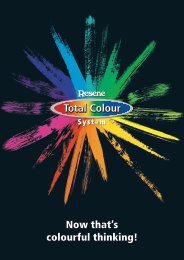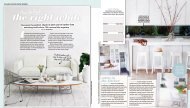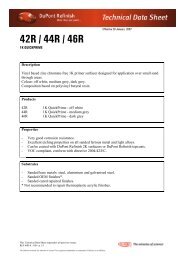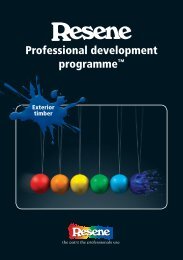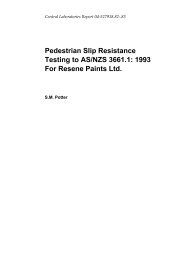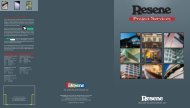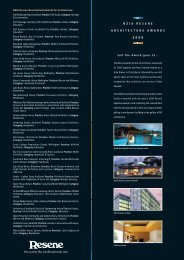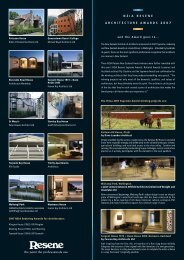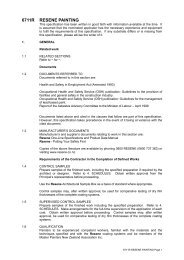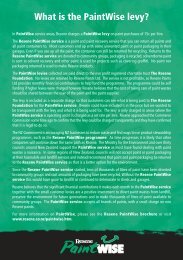Commercial - Resene
Commercial - Resene
Commercial - Resene
You also want an ePaper? Increase the reach of your titles
YUMPU automatically turns print PDFs into web optimized ePapers that Google loves.
AUT AJ School of Education<br />
North Shore Campus, Akoranga Drive<br />
The Akoranga campus is dominated by<br />
buildings inherited from the old North<br />
Shore Teachers’ College together with<br />
a few new high quality purpose built<br />
facilities. The AJ School of Education<br />
building is stage one of a masterplan that<br />
replaces old prefabs with new purpose<br />
built education facilities. The new building<br />
is pivotal in the development of the future<br />
campus and is sited and oriented to<br />
improve and shape the campus landscape<br />
and set up key circulation routes through<br />
the future campus.<br />
The building needed to accommodate<br />
the specific specialist requirements of<br />
Montessori and Steiner, while being<br />
flexible enough to cater for the general<br />
needs of the School of Education and the<br />
wider university.<br />
The building consists of strong Colorsteel®<br />
clad forms linked by decks and overlapping<br />
canopies, which run between them. The<br />
decks set up the new masterplan campus<br />
circulation axis and serve as additional<br />
teaching and study space. A second<br />
covered deck at the eastern end of the<br />
studio can be also be used as an outdoor<br />
learning space and breakout space.<br />
Architectural Specifier: Richard Harris<br />
(Director), Chris Scott (Project Director),<br />
Debora Laub, Vincent Kumar, David<br />
Mahon, Rose Fox, Vaughan Shepherd,<br />
Brad Middleton, Carl Read, Jasmax Ltd<br />
www.jasmax.co.nz<br />
Architectural Interior Design: Roxanne<br />
Spivey, Kathryn Roberts, Jasmax Ltd<br />
Building Contractor: The Fletcher<br />
Construction Company Limited<br />
Painting Contractor: The Fletcher<br />
Construction Company Limited<br />
Photographer: Emily Andrews<br />
The main building includes four classrooms,<br />
two Resource Laboratories, an arts studio,<br />
technical support, kitchen and ablutions.<br />
Linked by decks and overlapping canopies,<br />
is the separate multipurpose learning<br />
space and kitchenette.<br />
To produce such an economical, purpose<br />
built tertiary facility required careful<br />
consideration of every detail and building<br />
element. The relationship between space,<br />
technology and teaching pedagogy was<br />
a primary driver in the design of the<br />
buildings.<br />
Balancing the philosophies of Steiner<br />
(natural products) and Montessori<br />
(bright colours) resulted in the use<br />
of a neutral background palette enlivened<br />
by a varied palette of bright colours;<br />
applied as transparent stains on natural<br />
timber and plywood, as glazing film<br />
colours and as accent colours on carpet<br />
tiles.<br />
Stained cedar walls and soffits have been<br />
used both internally and externally to<br />
provide warmth and to highlight entry<br />
points. The south facing polycarbonate<br />
walls and the high ceilings create lofty<br />
light filled interiors.<br />
136<br />
The main classroom building consists of<br />
two Colorsteel® clad elements separated<br />
by the cedar and polycarbonate clad<br />
central studio spine. The interior is defined<br />
by a rich palette of brightly stained<br />
plywood storage cupboards which divide<br />
teaching spaces from studio space and<br />
open into both the classrooms and central<br />
studio.<br />
The separate large classroom employs the<br />
same material palette but is differentiated<br />
by colour. Materials and finishes are<br />
selected using the criteria of sustainability,<br />
durability and economy. The AUT School of<br />
Education buildings read conceptually as<br />
a group of simple strong forms, with each<br />
form defining a functional grouping of<br />
interior spaces. Their character comes from<br />
the relationship between the different<br />
forms. A considered composition using the<br />
devices of proportion, colour and texture<br />
is used to link, differentiate and enrich<br />
the forms without the need for expensive<br />
materials and added detail.



